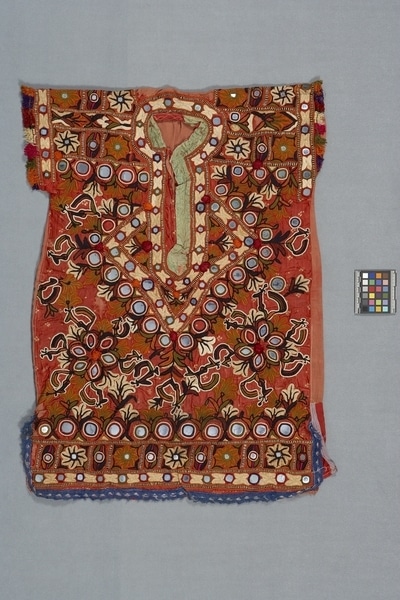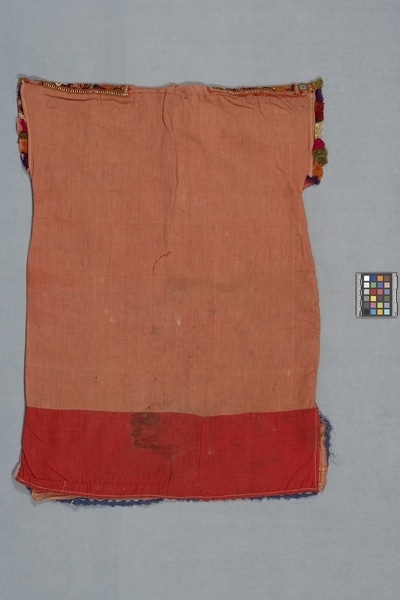Tunic Item Number: 1098/8 from the MOA: University of British Columbia


Description
Woman’s tunic; the front is heavily embroidered with multi-coloured designs on red-orange tie-dyed silk, and the back is made of plain red cotton textile. There are floral designs, mirrors and small pompoms over the entire surface of the tunic front. A large diamond-shaped panel of off-white embroidery surrounds the placket opening at the centre front. The placket and a narrow stand-up collar are made of plain light green silk textile trimmed with machine stitching. The armholes are trimmed with silk fringe. At the hem is a border of embroidered flowers and mirrors, finished with a edging of filmy blue and white braid. The back of the tunic is made of plain red-orange cotton textile; a strip of red cotton (16 cm) is sewn at the hemline. The embroidery is underlined with red-orange cotton textile.
History Of Use
This tunic is very similar in construction and design to a garment pictured on page 23 of Colours of the Indus. The authors call this type of garment a cholo.
Specific Techniques
Stitching techniques: buttonhole stitch; hem stitch; chain stitch; fly stitch. This embroidery style is called “pakka.”
Narrative
This tunic was purchased by William McLennan at Village Handicrafts in Karachi, Pakistan, in 1985 while he was on assignment for the Museum of Anthropology, which had a contract with the administration of Expo ‘86 to set up the Pakistan pavilion at the fair. The Museum purchased it, along with the other items in the 1098 accession, from McLennan in 1986.
Item History
- Made in Sindh, Pakistan before September 1985
- Collected by Bill McLennan during 1985
- Owned by Bill McLennan between September 1985 and January 30, 1986
- Received from Bill McLennan (Seller) and Museum of Anthropology Shop Volunteers (Funding source) on January 30, 1986
What
- Name
- Tunic
- Identification Number
- 1098/8
- Type of Item
- tunic
- Material
- cotton fibre, silk fibre, glass, silver alloy metal and dye
- Manufacturing Technique
- embroidered, sewn and appliqued
- Overall
- height 78.8 cm, width 56.0 cm
Who
- Culture
- South Asian
- Field Collector
- Bill McLennan
- Previous Owner
- Bill McLennan
- Received from
- Bill McLennan (Seller) and Museum of Anthropology Shop Volunteers (Funding source)
Where
- Holding Institution
- MOA: University of British Columbia
- Made in
- Sindh, Pakistan
When
- Creation Date
- before September 1985
- Collection Date
- during 1985
- Ownership Date
- between September 1985 and January 30, 1986
- Acquisition Date
- on January 30, 1986
Other
- Item Classes
- textiles
- Condition
- good
- Accession Number
- 1098/0008